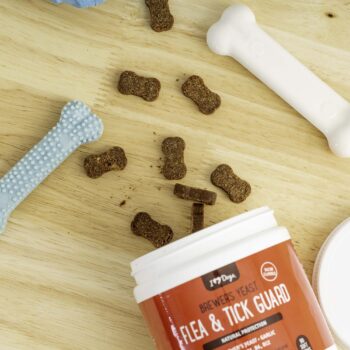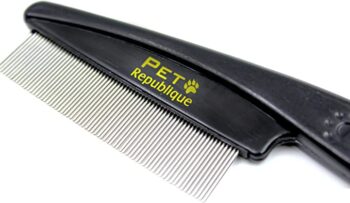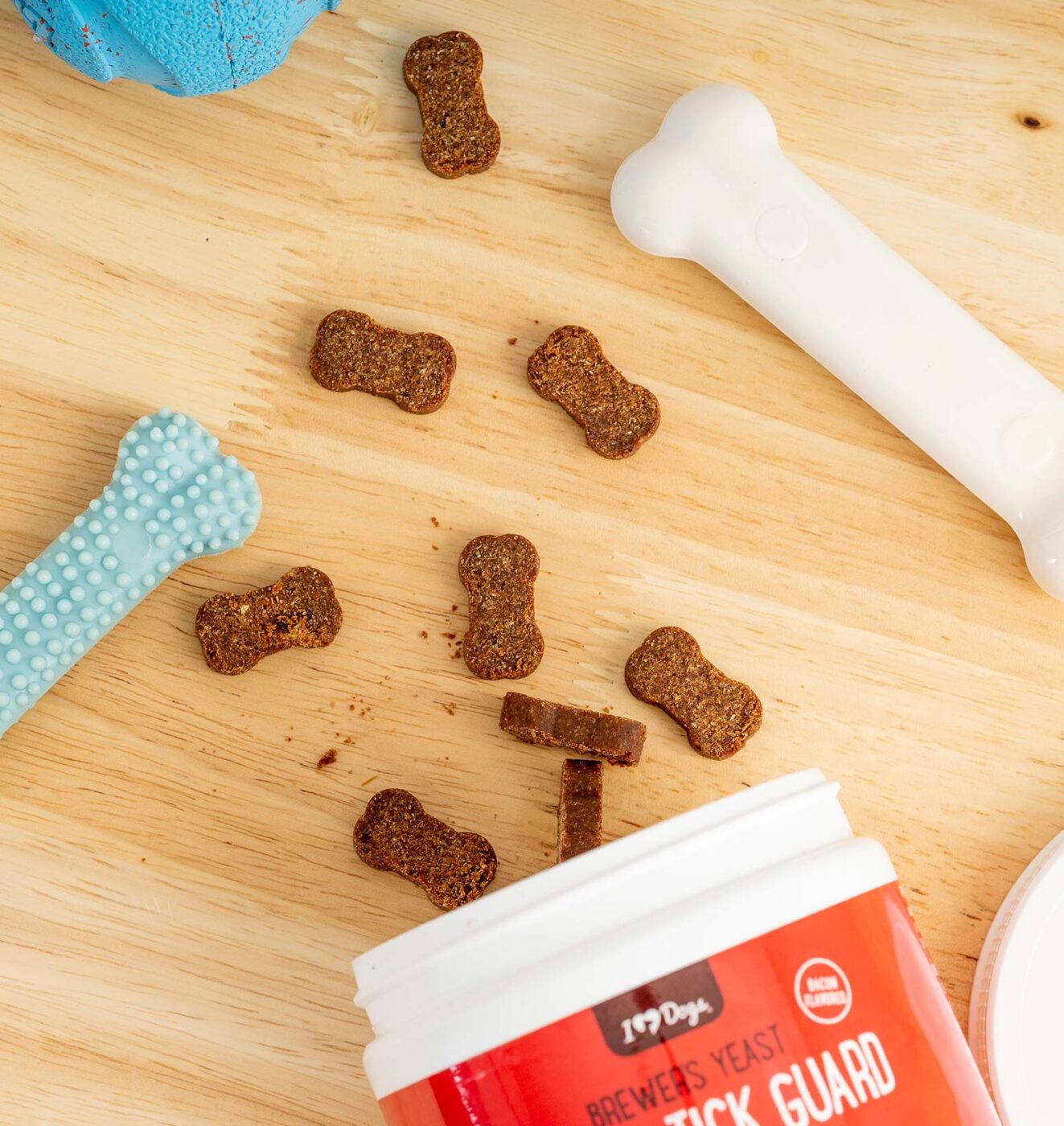
Nothing is more frustrating than finding a flea or tick on your beloved lab. In addition to driving your lab crazy, fleas and ticks can carry dangerous parasites and threaten the health of your beloved pup.
In this article, we’ll discuss a strategy for naturally preventing fleas and ticks from bothering your lab. In addition we’ll discuss the pros and cons of using natural methods compared to traditional chemical based pesticides.
Why Many Lab Parents Are Turning To Safer, Natural Flea & Tick Control Methods
Many pet parents are expressing concerns about using pesticide/chemical based bug repellants. In August of 2021, the FDA again warned dog and cat owners about the possible adverse effects of chemical flea repellants, including seizures, muscle tremors and ataxia. While the FDA states the majority of pets on these medications show no side-effects, a growing number of pet parents, including members of this 40,000+ member community on Facebook, beg to differ.
In addition to safety concerns, chemical based pesticides have an inherent flaw: fleas and ticks can adapt over time and become immune to the effects. This is why so many people have to rotate brands of traditional flea control products.
Chemical based pesticides, however, can be very effective for most dogs and can potentially prevent infestations better than natural methods. Ultimately, the choice is up to you and your veterinarian.
Even if you use pesticide based flea control products, you might consider also adding in natural flea/tick repellants which can be used along with traditional flea products, and boost their effectiveness.
4 Step Strategy for Safe & Effective Natural Flea & Tick Prevention for Your Lab
Natural prevention methods can work for your lab, if you can be diligent about these 4 areas:
#1 – Protect your lab from the inside out
Using nutrition and a natural supplement like this brewer’s yeast and garlic supplement , you can make your lab’s body inhospitable to fleas. Most dogs find the chews very tasty, and think they’re getting a treat.
#2 – Protect your lab from the outside in
Natural pet-safe essential oil sprays (many available on Amazon) can be applied to your lab’s fur and bedding, which helps prevents bugs from making their home on these surfaces. These products contain essential oils which repel fleas and ticks. Some products, such as the one pictured below, also include a plant based compound which kills fleas and their eggs.
#3 – Don’t forget about your yard and home!
A complete natural pest control program cannot ignore your dog’s environment. Even if you rid your dog of fleas, they will keep infesting your dog if the eggs exist in your home or yard. Our favorite natural method of killing fleas in and around your home is by using diatomaceous earth, available on Amazon or at most hardware stores. Unlike pesticides, DE kills pests mechanically anytime they touch the powder, which is harmless for pets and humans.
Another option is using a natural yard spray. Wondercide is a popular brand. These work similar to the pet spray above.
#4 – Check your lab daily for fleas and ticks
During the warmer months, make sure to check inspect your lab daily for fleas and ticks, especially if they spend a significant amount of time outdoors. Often times a sign of fleas will be flea dirt, the waste product that fleas leave behind in your dog’s fur. A flea comb is a simple tool that will help you discover these pests on your lab.
It should be noted that if your dog is already infested with fleas, you’re going to need to first rid them of the bugs before a natural flea repellant strategy can be effective.
Learn More about iHeartDog’s Tasty Flea & Tick Control Treats Below
The new iHeartDogs Flea & Tick Guard Bones are a natural way to help keep your dog pest-free. The tasty little chews incorporates a small amount of garlic to ward off pests. When eaten daily, the blend of brewer’s yeast and garlic tablets make your pup smell unpleasant to fleas and ticks making them stay away. The great part though is that humans and dogs can’t smell the odor!
Each chewable tablet is an excellent source of protein, trace minerals, and B-complex vitamins to help promote healthy skin & coat, maintain normal cellular growth and function, boost immune support, and enhance overall health. They’re also very tasty, even to the pickiest dogs! At $29.99 for a bottle of 90 tasty chews, it’ll only set you back about 66 cents a day for an average size dog.
Like all products sold by iHeartDogs, every purchase provides healthy meals for shelter dogs!
More Frequently Asked Questions About Flea & Tick Control Products for Labs
What’s better for my lab, natural or traditional pesticide based flea & tick products?
Ultimately, this is a question only you and your vet can answer. In our personal opinion, natural methods are less effective, but also less prone to dangerous side effects. Pesticide based products can also be easier to administer, but that downsides are possible side effects, some of which seem to be increasing.
What are the most common side effects of flea & tick medications for labs?
According to the FDA, the most common reported side effects for Isoxazoline products have been associated with neurologic adverse reactions, including muscle tremors, ataxia (cordination & balance problems), & seizures in some dogs and cats.
What’s the best natural flea & tick preventative for labs?
As detailed in the article above, we recommend a 4 prong approach:
(1) Use a natural brewer’s yeast + garlic supplement
(2) Use a natural flea & tick spray on your pet daily during warm months
(3) Treat your yard using a natural product such as diatomaceous earth or Wondercide
(4) Check your lab daily (during warmer months) for fleas and ticks.
Is Bravecto, NexGard, Simparica, Seresto and K9 Advantix II Safe for Labs?
Ultimately this is a question only you and your veterinarian can answer. According to the available FDA adverse reaction data, most pets do fine on these medications. However, adverse reactions appear to be increasing, or are possibly just now being reported more accurately (some estimates are that only 1% of adverse reactions are every reported to the FDA.) According to data compiled by Dr. W Jean Dodds and Jon P Kimball, approximately 60,909 pet deaths have been reported to the FDA from flea, tick, and heartworm medications (data up through April of 2021). Additionally, 15,77,958 total adverse reactions have been reported as well.
Data (USA) from FDA of reported adverse reactions & deaths after administering flea, tick and heartworm treatments – updated April 17th, 2021 |
||||
|---|---|---|---|---|
| Brand | Active drug ingredient | Date released | Adverse reactions | Deaths (including euthanasia) |
| Bravecto | fluralaner | 2014 | 43,602 | 1,533 |
| Bravetco plus | fluralaner+moxidectin | 2019-2020 | 77,459 | 4,753 |
| Comfortis | spinosad | 2012 | 1,62,354 | 4.816 |
| Trifexis | spinosad+milbemycin+oxime | 2011 | 2,00,941 | 6,662 |
| Credelio | lotilaner | 2018 | 3,302 | 95 |
| Revolution | selamectin | 2000 | 19,552 | 1,980 |
| Revolution plus | selamectin+sarolaner | 2019 | 31,605 | 2,346 |
| Nexgard | afoxolaner | 2013 | 36,340 | 1,086 |
| Nexgard Spectra | afoxolaner+milbemycin+oxime | 2014 | 1,90,802 | 5,998 |
| Simparica | sarolaner | 2016 | 14,153 | 432 |
| Simparica trio | sarolaner+moxidectin+pyrantel+pamoate | 2020 | 1,40,646 | 6,717 |
| Heartgard, Ivomec | ivermectin | 1996 | 94,798 | 4,103 |
| Heartgard Plus, Triheart | ivermectin+pyrantel+pamoate | 2003 | 1,05,139 | 5,332 |
| Iverhart Max | ivermectin+pyrantel+pamoate+praziquanel | 2018 | 1,29,815 | 6,207 |
| Interceptor | milbemyxin+oxime | 2013 | 1,54,190 | 3,911 |
| Interceptor Plus, Milbemax | milbemyxin+oxime+praziquantel | 2,01,02,015 | 1,72,860 | 4,938 |
| Totals: | 15,77,958 | 60,909 | ||
These statements have not been evaluated by the Food and Drug Administration. This product is not intended to diagnose, treat, cure, or prevent any disease. The information on this website is not intended to replace a one-on-one relationship with a qualified healthcare professional.
Top 9 Pet Insurance Plans for Labs (2022)
- CBD for Labs: What You Need to Know
- Best Supplements for a Senior Lab
- Best Flea & Tick Products for Labs
- Best Online Dog Training Courses for Lab
- Best Hip & Joint Supplement for a Lab
- What Supplements Should I Give a Lab Puppy?
- The 9 Best Lab Puppy Foods
- Best Dog Beds for Labs
- Improve Your Labs Skin & Coat with This One Hack
- Giving This to Your Lab Daily Can Alleviate Itchy Allergies
- 6 Natural Ingredients to Fight Your Labs Allergies
- 8 Ways to Stop Your Labs Scratching
- 7 Ways to Calm Your Labs Anxiety
- 6 Remedies for Your Labs Diarrhea, Gas, or Vomiting
- 7 Best Dental Chews for a Lab






 Toledo, United States.
Toledo, United States.